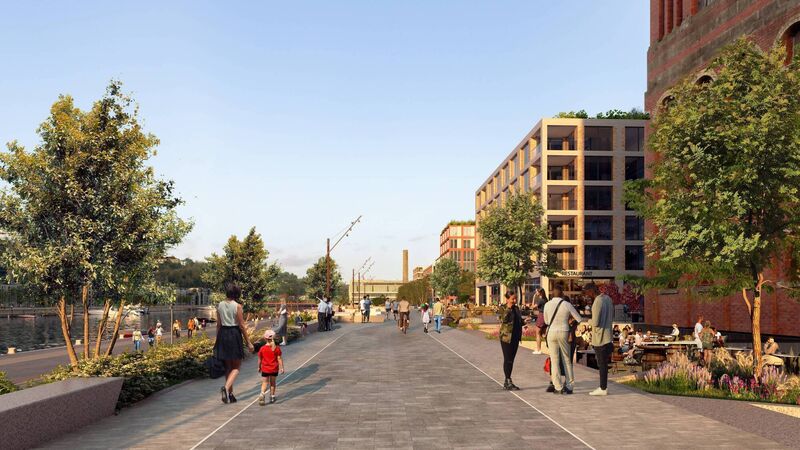New home starts on rise as buyer demand soars

Proposed public space at Cork Docklands. Up to €2.5 billion is set to be invested transforming Cork city, with significant investment in housing, sustainable transport, parks, public spaces and climate resilience over the next five years.
Home hunters face another tough year in 2024 – supply of both new and second-hand homes of all types and sizes is well below what is needed.
And the moderation seen in price growth last year is expected to continue in 2024, albeit with average price rise likely to continue in the low single digit price range – variously put at between 1 and 4% price growth by various analysts, depending on location and house type and condition.
A recent report from the Society of Chartered Surveyors Ireland (SCSI) put the forecasted increase at 1% for 2024, describing it as “modest”, and once again a majority (63%) of its surveyed members selling at the coalface reckoned that property prices “are at or nearing a peak.” This was said before.
It was the hope and expectation last year as interest rates rose and the market slowed … only for it to pick up pace again in the latter half of 2023. Those with even half-functioning memories will recall the same “calling the peak” back four and five years ago, pre-Covid, before the pandemic had the unexpected effect of driving on home values by double digit levels so that now they are 25-30% above pre-2020 levels.
While new homes starts are thankfully on the increase (see other accounts in this New Homes series of articles), the market once again is very short of stock across the board at a time of huge demand for homes to buy, rent and otherwise occupy.
The year 2023 ended with just 11,600 properties listed for sale on property website Myhome, down from 13,400 the previous quarter, Q3, and well below pre-pandemic levels of 20,000 listings of available, built/second-hand stock. (The national housing stock is 2.1 million, and so only about 0.6% of that was up for sale at the 11,600 listing level.) In terms of prices, the property website showed asking prices for existing stock for the last recorded full quarter increasing across nearly all Munster counties, by 2.3% in Cork to €285,000, up 2.7% in Clare, 5.5% in Limerick and 5.4% in Tipperary, while Waterford was up 7.1% to an average of €225,000. The only Munster county to show a drop in values was Kerry, dropping 3.3% to an average of €192,500.
Those prices clearly are averages, for all house types and state of condition and more precise locations, and in no way reflect the cost of new homes.
A seminal document, The Real Cost of New Housing produced by surveyors’ body the SCSI, did a valuable deep dive into the cost of building new houses last year and carrying forward into 2024, showed the average cost of building a new three-bed semi-detached house is now €397,000 nationally, or €386,000 if the Dublin region where prices average €461,000 is excluded.
The figure for Cork is put at €433,433 for an ‘out of the box’ new three-bed semi-d.
These figures are up roughly 25% over three years earlier, and up by an even heftier 39% up since 2016. (The same ‘Real Cost of Housing’ SCSI report put ‘hard costs’ for materials and labour at 53% of delivery costs, and ‘soft’ costs e land, margins, levies, finance costs VAT etc at 47%.
There’s clearly a widening affordability gap: this will not come as news to today’s home hunters seeing their options being restricted, desired homes ruled out, sizes shrinking or locations moving further and further out from established centres.
Keeping sales of new stock up has been buoyancy in the labour market, up to now at least. Irish Revenue estimates show that there has been a 50% rise since 2022 in the number of what they call tax units (single earners or jointly assessed couples) with incomes exceeding €100,000.
Meanwhile, a recent 2024 Myhome report showed average mortgage approvals approaching the €300k level, up 6% to €297,000 since the start of the year, and that was despite higher ECB rates which afflicted borrowers and would-be lenders since the war broke out in Ukraine just over two full year ago.
While there are hopes of an easing off in interest rates in mid-to later 2024, the ratcheted hikes we’ve witnessed have had an obvious effect on affordability for buyers and mortgage holders, and they have also acted as a disincentive for existing home owners to move and trade up or down if they had to take on a new mortgage, at those higher rates This clearly has had an impact on the volume of properties coming for sale, coming on top of sellers’ natural nervousness about putting their own current home up for sale if they might have to rent while waiting on their own next move, what with sky-high rents and, again, a huge dearth of rental accommodation.
And that’s another story.









